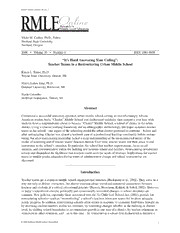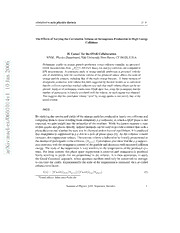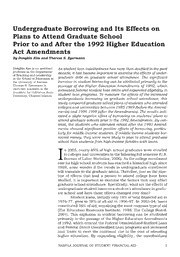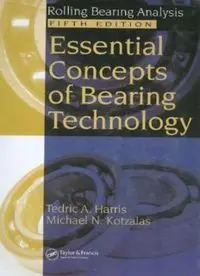
Essential Concepts of Bearing Technology, Fifth Edition (Rolling Bearing Analysis, Fifth Edtion) PDF
Preview Essential Concepts of Bearing Technology, Fifth Edition (Rolling Bearing Analysis, Fifth Edtion)
Rolling Bearing Analysis F I F T H E D I T I O N Essential Concepts of Bearing Technology ß2006 by Taylor & Francis Group, LLC. ß 2006 by Taylor & Francis Group, LLC. Rolling Bearing Analysis F I F T H E D I T I O N Essential Concepts of Bearing Technology Tedric A. Harris Michael N. Kotzalas ß 2006 by Taylor & Francis Group, LLC. CRC Press Taylor & Francis Group 6000 Broken Sound Parkway NW, Suite 300 Boca Raton, FL 33487-2742 © 2007 by Taylor & Francis Group, LLC CRC Press is an imprint of Taylor & Francis Group, an Informa business No claim to original U.S. Government works Printed in the United States of America on acid-free paper 10 9 8 7 6 5 4 3 2 1 International Standard Book Number-10: 0-8493-7183-X (Hardcover) International Standard Book Number-13: 978-0-8493-7183-7 (Hardcover) This book contains information obtained from authentic and highly regarded sources. Reprinted material is quoted with permission, and sources are indicated. A wide variety of references are listed. Reasonable efforts have been made to publish reliable data and information, but the author and the publisher cannot assume responsibility for the validity of all materials or for the consequences of their use. No part of this book may be reprinted, reproduced, transmitted, or utilized in any form by any electronic, mechanical, or other means, now known or hereafter invented, including photocopying, microfilming, and recording, or in any informa- tion storage or retrieval system, without written permission from the publishers. For permission to photocopy or use material electronically from this work, please access www.copyright.com (http:// www.copyright.com/) or contact the Copyright Clearance Center, Inc. (CCC) 222 Rosewood Drive, Danvers, MA 01923, 978-750-8400. CCC is a not-for-profit organization that provides licenses and registration for a variety of users. For orga- nizations that have been granted a photocopy license by the CCC, a separate system of payment has been arranged. Trademark Notice: Product or corporate names may be trademarks or registered trademarks, and are used only for identification and explanation without intent to infringe. Visit the Taylor & Francis Web site at http://www.taylorandfrancis.com and the CRC Press Web site at http://www.crcpress.com ß 2006 by Taylor & Francis Group, LLC. Preface Ball and roller bearings, together called rolling bearings, are commonly used machine elem- ents. They are used to permit motion of, or about, shafts in simple commercial devices such as bicycles, roller skates, and electric motors. They are also used in complex mechanisms such as aircraft gas turbines, rolling mills, dental drills, gyroscopes, and power transmissions. Until around 1940, the design and application of these bearings involved more art than science. Since 1945, marking the end of World War II and the beginning of the atomic age, scientific progress has occurred at an exponential pace. Since 1958, the date that marks the commence- ment of space travel, continually increasing demands have been made of engineering equip- ment. To ascertain the effectiveness of rolling bearings in modern engineering applications, a firm understanding of how these bearings perform under varied and often extremely demand- ing conditions of operation is necessary. A substantial amount of information and data on the performance of rolling bearings is presented in manufacturers’ catalogs. These data are mostly empirical in nature, obtained from the testing of products by the larger bearing manufacturing companies, or, more likely for smaller manufacturing companies, from information in various standards publications, for example, the American National Standards Institute (ANSI), Deutsches Institut fu¨r Normung (DIN), International Organization for Standardizations (ISO), etc. These data pertain only to bearing applications involving slow-to-moderate speed, simple loading, and nominal operating temperatures. To evaluate the performance of bearing applications oper- ating beyond these bounds, it is necessary to return to the basics of rolling and sliding motions over the concentrated contacts that occur in rolling bearings. One of the first books on this subject was Ball and Roller Bearing Engineering by Arvid Palmgren, Technical Director of ABSKF for many years. It explained, more completely than any other book previously, the concept of rolling bearing fatigue life. Palmgren and Gustav Lundberg, Professor of Mechanical Engineering at Chalmers Institute of Technology in Go¨teborg, Sweden, proposed theory and formulas on which the current national and ISO standards for the calculation of rolling bearing fatigue life are based. Also, A. Burton Jones’ text, Analysis of Stresses and Deflections, gave a good explanation of the static loading of ball bearing. Jones, who worked in various technical capacities for the New Departure Ball Bearing Division of General Motors Corporation, Marlin-Rockwell Corporation, and Fafnir Ball Bearing Company, and also as a consulting engineer, was among the first to use digital computers to analyze the performance of ball and roller bearing shaft-bearing-housing systems. Other early texts on rolling bearings are largely empirical in their approaches to applications analysis. Since 1960, much research has been conducted on rolling bearings and rolling contact. The use of modern laboratory equipment such as scanning and transmission electron micro- scopes, x-ray diffraction devices, and digital computers has shed much light on the mechan- ical, hydrodynamic, metallurgical, and chemical phenomena involved in rolling bearing operations. Many significant technical papers have been published by various engineering societies, for example, the American Society of Mechanical Engineers, the Institution of Mechanical Engineers, the Society of Tribologists and Lubrication Engineers, and the Japan Society of Mechanical Engineers, among others, analyzing the performance of rolling bearings in exceptional applications involving high-speed, heavy-load, and extraordinary internal design and materials. Substantial attention has been given to the mechanisms of ß 2006 by Taylor & Francis Group, LLC. rolling bearing lubrication and the rheology of lubricants. Notwithstanding the existence of the aforementioned literature, there remains a need for a reference that presents a unified, up- to-date approach to the analysis of rolling bearing performance. That is the purpose of this book. To accomplish this goal, significant technical papers and texts covering the performance of rolling bearings, their constituent materials, and lubrication were reviewed. The concepts and mathematical presentations contained in the literature have been condensed and simpli- fied in this book for rapidity and ease of understanding. It should not be assumed, however, that this book supplies a complete bibliography on rolling bearings. Only data found useful in practical analysis have been referenced. The format of Rolling Bearing Analysis, Fifth Edition is aimed at understanding the principles of rolling bearing design and operation. In this edition, the material has been separated into two volumes: Essential Concepts of Bearing Technology and Advanced Concepts of Bearing Technology. The first volume is for the users of bearings who require only a basic understanding, whereas the second volume enables users involved in complex bearing appli- cations to carry bearing performance analysis to the degree necessary for a solution of their application. The first volume is a stand-alone text; however, the second volume frequently refers to basic concepts explained in the first volume. To amplify the discussion, numerical examples are referenced in several chapters. For each volume, these examples are contained in a CD-ROM provided inside the back cover of the text. Several of the examples deal with a 209 radial ball bearing, a 209 cylindrical roller bearing, a 218 angular-contact ball bearing, and a 22317 spherical roller bearing. Design and performance data for each bearing are accumulated as the reader progresses through the book. The examples are carried out in metric or Standard International (SI) system of units (millimeters, Newtons, seconds, 8C, and so on); however, the results are also given paren- thetically in the English system of units. In the appendix, the numerical constants for equations presented in SI or metric system units are provided in the English system of units as well. Also contained on the CD-ROM are many tables of bearing dimensional, mounting, and life rating data obtained from ABMA/ANSI standards. These tables are referenced in the text as, for example, Table CD2.1; data from the tables are used in the solution of many of the numerical examples. The text material spans many scientific disciplines, for example, geometry, elasticity, statics, dynamics, hydrodynamics, statistics, and heat transfer. Thus, many mathematical symbols have been employed. In some cases, the same symbol has been chosen to represent different parameters. To help avoid confusion, a list of symbols is presented at the beginning of most chapters. Because these two books span several scientific disciplines, the treatment of topics varies in scope and manner. Where feasible, mathematically developed solutions to problems are presented. On the other hand, empirical approaches to problems are used where it is more practical. The combination of mathematical and empirical techniques is particularly evident in chapters covering lubrication, friction, and fatigue life. As stated previously, the material presented herein exists substantially in other publica- tions. The purpose of these books is to concentrate that knowledge in one place for the benefit of both the student and the rolling bearing user who needs or wants a broader understanding of the technical field and the products. The references provided at the end of each chapter enable the curious reader to go into further detail. Since 1995, the American Bearing Manufacturers Association (ABMA) has sponsored short courses on rolling bearing technology at The Pennsylvania State University. The one-week course, ‘‘Advanced Concepts of Bearing Technology,’’ is based on the material in ß 2006 by Taylor & Francis Group, LLC. Rolling Bearing Analysis, Third and Fourth Editions. Some students, however, believed that a preliminary three-day course, ‘‘Essential Concepts of Bearing Technology,’’ was required to provide sufficient background to successfully complete the advanced course. The latter course is now presented annually; this Essential Concepts of Bearing Technology will be used for that course. Because of my long-time association with the SKF company, as with the previous editions of this book, several of the illustrations in this fifth edition have previously appeared in SKF publications; for such illustrations, appropriate references are identified. Photographs and illustrations from other rolling bearing manufacturers are included as well. The following companies are gratefully acknowledged for contributing photographic material: INA/FAG, NSK Corporation, NTN Bearing Corporation of America, and The Timken Company. The contributor of each such illustration is identified. During my time as professor of mechanical engineering at The Pennsylvania State Uni- versity, I had the pleasure of supervising and guiding the pursuit of the M.S. and Ph.D. degrees by Michael N. Kotzalas. Since graduation in 1999, he has been employed by The Timken Company and has greatly expanded his knowledge of, and activities in, the rolling bearing engineering and research field. It is therefore with great satisfaction that I welcome him as co-author of this fifth edition, to which he has made significant contributions. Tedric A. Harris ß 2006 by Taylor & Francis Group, LLC. ß 2006 by Taylor & Francis Group, LLC. Authors Tedric A. Harris is a graduate in mechanical engineering from the Pennsylvania State University, having received a B.S. in 1953 and an M.S. in 1954. After graduation, he was employed as a development test engineer at the Hamilton Standard Division, United Aircraft Corporation, and later as an analytical design engineer at the Bettis Atomic Power Labora- tory, Westinghouse Electric Corporation. In 1960, he joined SKF Industries, Inc. in Phila- delphia, Pennsylvania, as a staff engineer. While at SKF, he held several key management positions: manager, Analytical Services; director, Corporate Data Systems; general manager, Specialty Bearings Division; vice president, Product Technology & Quality; president, SKF Tribonetics; vice president, Engineering & Research, MRC Bearings (all in the United States); director for Group Information Systems at SKF Headquarters, Gothenburg, Sweden; and managing director of the Engineering & Research Center in the Netherlands. He retired from SKF in 1991 and was appointed as a professor of mechanical engineering at The Pennsylvania State University, University Park. He taught courses in machine design and tribology and conducted research in the field of rolling contact tribology at the university until retirement in 2001. Currently, he conducts a consulting engineering practice and, as adjunct professor in mechanical engineering, teaches courses in bearing technology to graduate engineers in the University’s Continuing Education Program. He is the author of 67 technical publications, mostly on rolling bearings. In 1965 and 1968, he received Outstanding Technical Paper awards from the Society of Tribologists and Lubri- cation Engineers and in 2001 from the American Society of Mechanical Engineers (ASME) Tribology Division. In 2002, he received the Outstanding Research Award from the ASME. He has served actively in numerous technical organizations, including the Anti-Friction Bearing Manufacturers’ Association (now ABMA), ASME Tribology Division, and ASME Research Committee on Lubrication. He was elected ASME Fellow Member in 1973. He has served as chair of the ASME Tribology Division and of the Tribology Division’s Nominations and Oversight Committee. He holds three U.S. patents. Michael N. Kotzalas graduated from The Pennsylvania State University with a B.S. in 1994, M.S. in 1997, and Ph.D. in 1999, all in mechanical engineering. During this time, the focus of his study and research was on the analysis of rolling bearing performance, including quasidynamic modeling of ball and cylindrical roller bearings for high-acceleration applica- tions and spall progression testing and modeling for use in condition-based maintenance algorithms. Since graduation, he has been employed by The Timken Company in its research and development wing and most recently in the Industrial Bearing Business. His current responsibilities include advanced product design and application support for industrial bearing customers, whereas prior responsibilities included new product and analysis algo- rithm development. For this work, he received two U.S. patents for cylindrical roller bearing designs. Outside of work, he is also active in industrial societies. As a member of the American Society of Mechanical Engineers (ASME), Dr. Kotzalas currently serves as the chair of the Publications Committee and as a member of the Rolling Element Bearing Technical Committee. With the Society of Tribologists and Lubrication Engineers (STLE), he is a ß 2006 by Taylor & Francis Group, LLC.
The list of books you might like

Atomic Habits James Clear

Mind Management, Not Time Management

The Sweetest Oblivion (Made Book 1)

Believe Me
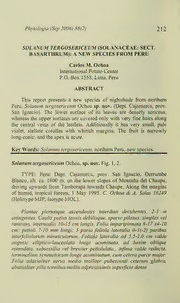
Solanum tergosericeum (Solanaceae: sect. Basarthrum): a new species from Peru
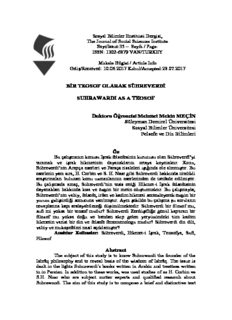
BİR TEOSOF OLARAK SÜHREVERDİ SUHRAWARDI AS A TEOSOF Doktora Öğrencisi Mehmet ...
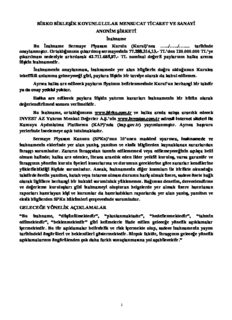
BİRKO BİRLEŞİK KOYUNLULULAR MENSUCAT TİCARET VE SANAYİ ANONİM ŞİRKETİ
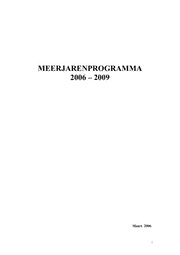
Meerjarenprogramma 2006-2009
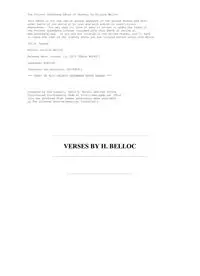
Verses by Hilaire Belloc

2006 Social Club Program
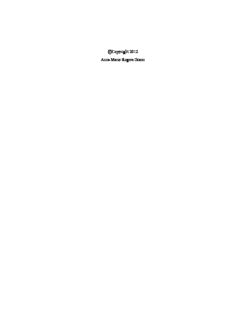
c Copyright 2012 Anna Marie Rogers Dixon
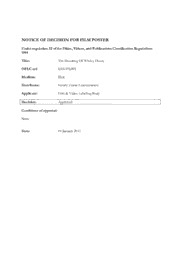
The Haunting Of Whaley House
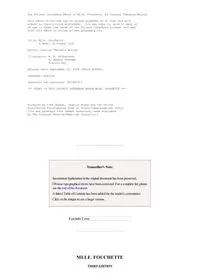
Mlle Fouchette by Charles Theodore
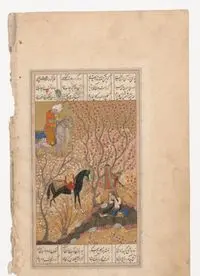
rbsc isl msp-leaf 018

Lawrence Weiner

Siete velas

CALAIS Theo

Oracle Primavera P6 Version 8: Project and Portfolio Management

Greek Government Gazette: Part 2, 1993 no. 423
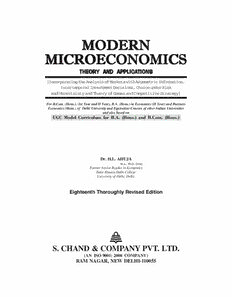
MODERN MICROECONOMICS THEORY AND APPLICATIONS

